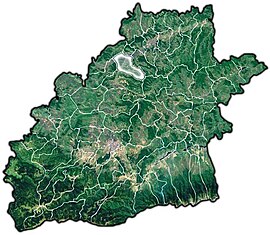Axente Sever, Sibiu
Axente Sever | |
|---|---|
 | |
 Location in Sibiu County | |
| Coordinates: 46°6′N 24°13′E / 46.100°N 24.217°E | |
| Country | Romania |
| County | Sibiu |
| Population (2021-12-01)[1] | 3,286 |
| Time zone | EET/EEST (UTC+2/+3) |
| Postal code | 557025 |
| Vehicle reg. | SB |
| Website | axentesever |
Axente Sever (until 1931 Frâua; German: Frauendorf; Hungarian: Asszonyfalva) is a commune located in Sibiu County, Transylvania, Romania, named after Ioan Axente Sever.
The commune is composed of three villages: Agârbiciu (Arbegen; Szászegerbegy), Axente Sever and Șoala (Schaal; Sálya). In each of these three villages there are Saxon fortified churches erected in the 14th century and fortified till the 16th century.
The route of the Via Transilvanica long-distance trail passes through the villages of Axente Sever and Agârbiciu.[2]
Etymology
[edit]The village's original name, Frauendorf, refers to the fact that the village was under the jurisdiction of a Saxon princess. The village's contemporary Romanian name originates from the name of Axente Sever, a controversial revolutionary, propagandist, and theologian born in the village.
History
[edit]Archeological remains from the neolithic, early bronze age, early iron age, and Roman period have all been found in the area around the village.[3]
In the 12th century, Saxons settled the area, and constructed a gothic fortified church on the ruins of an older church. Documents attest that this church was standing by at least 1330. From the 15th century until the Treaty of Trianon in 1920, the village was a part of Nagy-Küküllő County, Hungary.
In 1910, the village was majority German, with a Romanian minority. Following the Second World War, the German population, which lived in the village for over 800 years was forcibly deported.[citation needed]
Gallery
[edit]-
Fortified Church of Axente Sever
-
Fortified Church of Axente Sever
-
Fortified Church of Axente Sever
-
Axente Sever
-
The main street
-
Transylvanian Saxons dancing in Frauendorf
References
[edit]- ^ "Populaţia rezidentă după grupa de vârstă, pe județe și municipii, orașe, comune, la 1 decembrie 2021" (XLS). National Institute of Statistics.
- ^ "Terra Saxonum | Via Transilvanica". www.viatransilvanica.com (in Romanian). Retrieved 2023-08-14.
- ^ Luca, Sabin Adrian; Pinter, Zeno-Karl; Georgescu, Adrian (2003). Repertoriul arheologic al judeţului Sibiu: (situri, monumente arheologice şi istorice) = The archaeological repertoire of sibiu district: settlements, archaeological and historical monuments. Bibliotheca Septemcastrensis. Bucureşti: Ed. Economică. ISBN 978-973-590-856-0.
Augustin Ioan and Hanna Derer. The Fortified Churches of the Transylvanian Saxons. Noi Media Print, 2004








